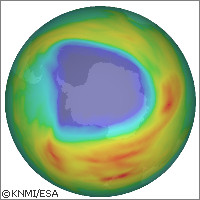Ozone hole grows but is below 2006 record
Scientists from the German Aerospace Centre (DLR) have discovered that the ozone hole over Antarctica has expanded this year against what it was in 2007, but is smaller than what it was in 2006. The ozone is a protective atmospheric layer protecting Earth from harmful ultraviolet rays. Failure to shield the planet can trigger a multitude of health ailments in people and harm biodiversity. While the ozone hole reached 27 million square kilometres in 2008, against 25 million square kilometres the year before, it was still under the 29 million square kilometres recorded in 2006, which is equal to about the size of North America. Extreme cold temperatures at high altitude wreak havoc on the ozone layer, as do harmful atmospheric gases like bromine. Man-made products, such as chlorofluorocarbons (CFCs) that were developed in the 1930s, strongly perpetuated the problem. According to scientists, 1 CFC molecule can trigger the loss of 100,000 ozone molecules. Found in cleaning solvents and aerosols, CFCs were phased out under the 1987 'Montreal Protocol on Substances that Deplete the Ozone Layer'. Targeting the protection of the stratospheric ozone layer, the international agreement was inked 21 years ago and later amended in 1990 and 1992. Scientists say weather conditions affect the size of the ozone hole over Antarctica each year. During the winter season in the southern hemisphere, the polar vortex cuts off any exchanges between the atmosphere above Antarctica and mid-latitude air. The result is the depletion of the main chemical ozone, scientists explain. This vortex, a persistent cyclone, is at its strongest during winter and declines during the summer months. Stratospheric clouds (PSCs), also known as nacreous clouds, emerge from extreme low temperatures that characterise the polar vortex. PSCs support chemical reactions that generate active chlorine, which in turn catalyse ozone destruction, experts say. 'In 2007, a weaker meridional heat transport was responsible for colder temperatures in the stratosphere over the Antarctic, leading to an intensified formation of PSCs in the stratosphere,' Professor Julian Meyer-Arnek of the DLR said, commenting on the regional meteorological conditions related to the time and range of the ozone hole when comparing 2007 with 2008. 'Therefore, we saw a fast ozone-hole formation in the beginning of September 2007.' The DLR scientist went on to say that stronger-than-usual meridonal heat transport triggered warmer temperatures in the Antarctic stratosphere than usual, reducing PSC formation. 'Consequently, the conversion of chemically inactive halogens into ozone-destroying substances was reduced,' he said. The result is that the size of the ozone hole was smaller than average towards the end of summer. Meanwhile, Professor Meyer-Arnek said, 'Since the polar vortex remained undisturbed for a long period, the 2008 ozone hole became one of the largest ever observed.' DLR based its analysis on the Scanning Imaging Absorption Spectrometer for Atmospheric Cartography (SCIAMACHY) atmospheric sensor onboard the European Space Agency's (ESA) Envisat; the Global Ozone Monitoring Experiment (GOME) aboard ESA's ERS-2; and the GOME-2 instrument aboard MetOp of the EUMETSAT. Experts believe that while annual variability in temperature and atmospheric dynamics are key components in determining the size and time of the ozone hole, it is not easy to determine the signs of ozone recovery. But the DLR scientist said that queries about how the ozone hole can be recovered and how atmospheric dynamics will affect future ozone holes will draw in the scientists of the future.
Countries
Germany



